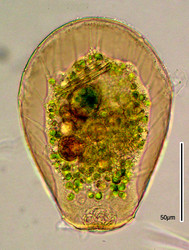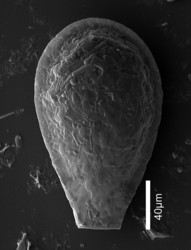Hyalospheniidae
Ralf Meisterfeld and Edward Mitchell- Hyalosphenia Stein 1859
- Leptochlamys
- Nebela Leidy 1874
- Alocodera
- Apodera Loeblich & Tappan 1981
- Certesella Loeblich & Tappan 1961
- Physochila
- Porosia
- Schoenbornia
Characteristics
Test rigid, either chitinoid, clear, completely organic, non areolar or agglutinate composed of shell plates of small euglyphids (e.g. Euglypha, Trinema, Tracheleuglypha), or plates of Quadrulella and diatom fragments. The shape of the tests varies between genera and species, but tests are often oval to flask-shaped, compressed, and the pseudostome is always terminal.
The assumption in the older literature that genera like Nebela, Apodera etc. can synthesize their own siliceous ideosomes has not been proven. There is some evidence from scanning electron microscopy that members of the genus Argynnia, which is traditionally placed in this group, can coat foreign building material. Usually genera that use external material (e.g. Nebela, Apodera or Certesella) fix the building material in a sheet-like organic cement matrix, which is normally visible between the plates; only Argynnia and Physochila use distinct cement units. In some species, under building-material-limited conditions, the test can be completely organic (e.g. N. tincta, A. cockayni).
Classification
The concept of the family Hyalospheniidae has changed during the last century. Deflandre (1953) has included most of the genera that are here treated in the Heleoperidae, Hyalospheniidae or Lesqueusiidae in the family Nebelidae.
Meisterfeld (2002) has classified the genera we treat here in this group in two separate families:
- Hyalospheniidae (Hyalosphenia, Leptochlamys)
Genera with a rigid, chitinoid, completely organic and non-areolar test. - Nebelidae (Nebela, Alocodera, Apodera, Argynnia, Certesella, Physochila, Porosia, Schoenbornia?)
Genera with tests composed of shell plates of small euglyphids (e.g. Euglypha, Trinema, Tracheleuglypha) or plates of Quadrulella and diatom fragments.
Lara et al. (2008) have shown with molecular data that the family is probably not monophyletic and that some genera are perhaps paraphyletic. But a new classification that reflects the phylogenetic relations between Hyalosphenia and the old families Nebelidae and Heleoperidae correctly is not yet available.
Deflandre (1936) has proposed several groups within Nebela to accommodate the large morphological diversity in this genus. Jung (1942) split Nebela into 11 genera unfortunately without type designations. Only the monotypic genera are valid, all others are nomina nuda. With the exception of Physochila none of the genera have been recognised by subsequent workers. Loeblich & Tappan (1961) validated Apodera and Certesella. Here, genera with structured cement and distinct shell morphology (Argynnia, Physochila) and those taxa with sheet-like cement, sufficient morphological particularity and restricted geographic distributions are recognised as distinct genera, the remaining species being assigned to Nebela. But the position of Argynnia, Physochila and Schoenbornia remains uncertain.
References
Deflandre, G. 1936. Etude monographique sur le genre Nebela Leidy (Rhizopoda - Testacea). Ann. Protistol., 5:201-286.
Jung, W. 1942 Südchilenische Thekamöben. (Aus dem südchilenischen Küstengebiet, Beitrag 10). Arch. Protistenk., 95:253-356.
Lara, E., Heger, T.J., Ekelund, F, Lamentowicz and Mitchell, E.A.D. 2008: Ribosomal RNA Genes challenge the monophyly of the Hyalospheniidae (Amoebozoa: Arcellinida). Protist 159: 165-176.
Loeblich, A. R. JR. & Tappan, H. 1961. Remarks on the systematics of the Sarkodina (Protozoa) renamed homonyms and new and validated genera. Proc. Biol. Soc. Wash., 74: 213-234.
Meisterfeld, R. 2002. Order Arcellinida Kent. In: An Illustrated Guide to the Protozoa. Lee, J.J.; Leedale, G.F. & Bradbury, P. (eds.). 2nd edition. Soc. of Protozoologists, Lawrence Kansas U.S.A., Allen Press Inc. Vol 2: 827 860.
Title Illustrations

| Scientific Name | Hyalosphenia papilio |
|---|---|
| Identified By | Edward Mitchell |
| Copyright |
© Edward Mitchell

|
About This Page
This page is being developed as part of the Tree of Life Web Project Protist Diversity Workshop, co-sponsored by the Canadian Institute for Advanced Research (CIFAR) program in Integrated Microbial Biodiversity and the Tula Foundation.

Rheinisch-Westfälische Technische Hochschule Aachen, Germany
Edward Mitchell

University of Neuchâtel
Correspondence regarding this page should be directed to Ralf Meisterfeld at and Edward Mitchell at
Page copyright © 2008 and Edward Mitchell
All Rights Reserved.
- First online 02 September 2008
- Content changed 02 September 2008
Citing this page:
Meisterfeld, Ralf and Edward Mitchell. 2008. Hyalospheniidae. Version 02 September 2008 (under construction). http://tolweb.org/Hyalospheniidae/124527/2008.09.02 in The Tree of Life Web Project, http://tolweb.org/










 Go to quick links
Go to quick search
Go to navigation for this section of the ToL site
Go to detailed links for the ToL site
Go to quick links
Go to quick search
Go to navigation for this section of the ToL site
Go to detailed links for the ToL site